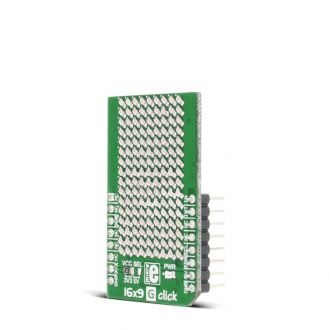
We strongly encourage users to use Package manager for sharing their code on Libstock website, because it boosts your efficiency and leaves the end user with no room for error. [more info]

Rating:
Author: MIKROE
Last Updated: 2018-05-21
Package Version: 1.0.0.1
mikroSDK Library: 1.0.0.0
Category: LED matrix
Downloaded: 7153 times
Not followed.
License: MIT license
16x9 G click contains a green LED matrix and the IS31FL3731 audio modulated matrix LED driver. The dimension of the LED matrix is 16x9. Each LED can be controlled individually – both for on/off control and light intensity.
Do you want to subscribe in order to receive notifications regarding "16x9 G click" changes.
Do you want to unsubscribe in order to stop receiving notifications regarding "16x9 G click" changes.
Do you want to report abuse regarding "16x9 G click".


Library Description
The library initializes and defines the I2C bus driver that offers a choice for writing data in the register. The library includes a function for displaying one character, image, or rectangle drawing. The user also has the function for display refresh and control all LEDs.
Key functions:
void c16x9g_drawPoint(uint8_t x, uint8_t y, uint8_t pwm) - Functions for draw point void c16x9g_displayByte(char ch, uint8_t frame, uint8_t pwm) - Function for displaying one charactervoid c16x9g_displayRefresh() - Function for refresh displayvoid c16x9g_displayImage(uint8_t *pImage, uint8_t frame, uint8_t pwm) - Image display functionExample description
The application is composed of three sections:
void applicationTask()
{
c16x9g_displayRefresh();
c16x9g_displayByte(demoChar, C16X9G_FRAME_1, 250);
Delay_1sec();
c16x9g_displayRefresh();
c16x9g_displayImage(&demoImageOn[0], C16X9G_FRAME_1, 250);
Delay_1sec();
c16x9g_displayRefresh();
c16x9g_displayImage(&demoImageOff[0], C16X9G_FRAME_1, 250);
Delay_1sec();
c16x9g_displayRefresh();
c16x9g_drawRectangle(1,4,6,4,250);
Delay_1sec();
}
Other MikroElektronika libraries used in the example:
Depending on the development board you are using, you may need USB UART click, USB UART 2 click or RS232 click to connect to your PC, for development systems with no UART to USB interface available on the board. The terminal available in all MikroElektronika compilers, or any other terminal application of your choice, can be used to read the message.